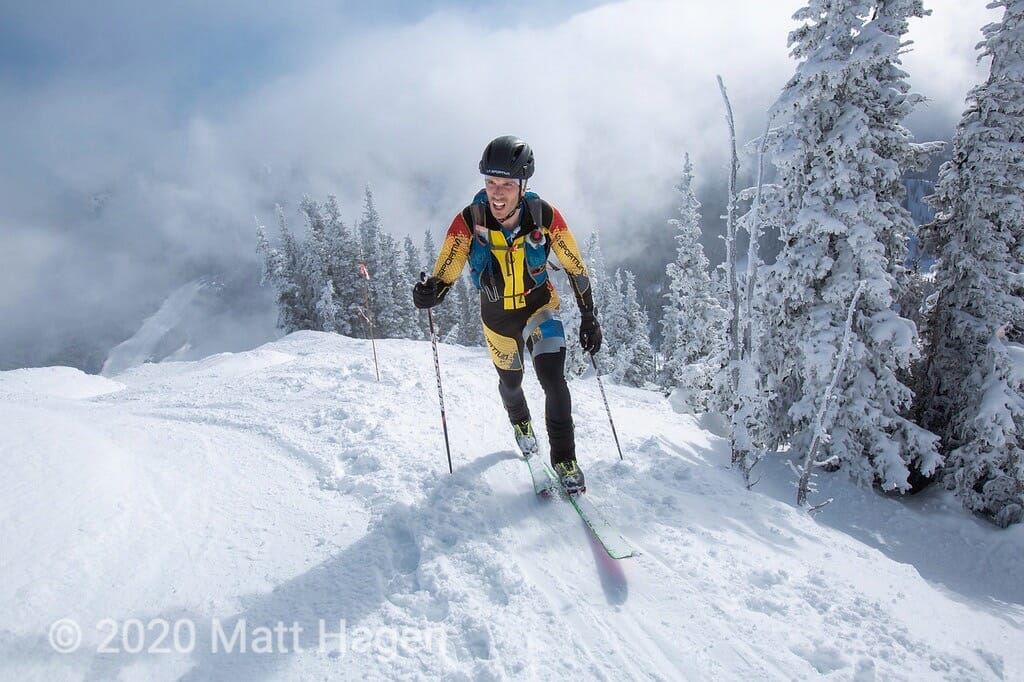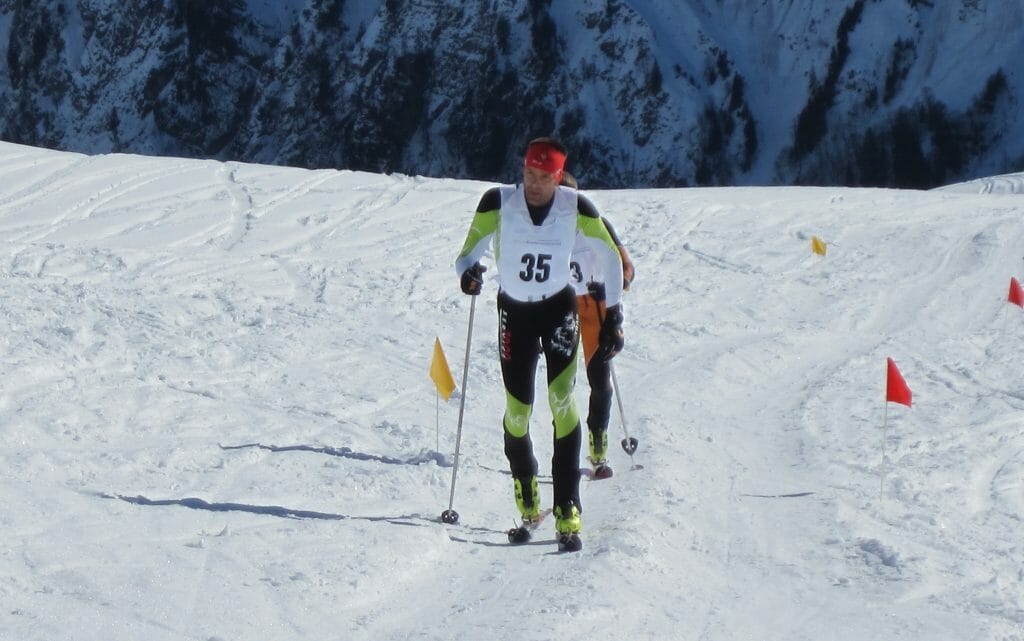Winter-sport athletes face a unique problem when it comes to training for their disciplines. Cross-country ski racers train seven to eight months of the year—NOT doing their sport—in preparation for a four-to-five-month racing season. These athletes have had to become very clever about sport mimicry to fool their muscular and nervous systems into believing that they are doing something very close to skiing. They call this dryland training. Off-season training can be just as beneficial for skimo racers, who would be wise to experiment with some of the methods and techniques their cross-country brethren rely on between winters.
Skimo Off-Season Training
If you are waiting until November or December to start training for your skimo season and wondering where you might find an extra edge in your upcoming races, then you should look no further than your dryland season. A good 90 percent of your performance results during race season can be attributed to the work you do in those long months without snow. If you are not taking advantage of this off-season, then you have no one to blame for your lack of results but yourself.
That new ultra-lightweight (and ultra-expensive) setup WILL help you … drop your times by 1–2 percent. For sure there are those elite few for whom that extra margin will be decisive in victory. But for most of the field, proper off-season training can net you gains well into the double digits.
Off-season is the time for building your base, meaning improving your ability to handle ever-increasing training loads. First and foremost this should focus on your aerobic system, but strength and technical proficiency should not be ignored.

Technical Skill Development
Some skimo racers today are coming into the sport without a strong ski background, either in cross-country ski racing or downhill skiing. These new skiers lack the ski-feel of an experienced skier. Skinning uphill is a lot more than just putting one foot in front of the other more quickly than the next guy. The race courses may be roughly evenly divided between uphill and downhill with a small portion of flats, but the time spent on the uphills, to say nothing of the energy expenditure required to climb them, makes the uphill portions of the event the places where you stand to gain or lose the most time.
Most racers falsely attribute their relative success or failure to their fitness alone. We all recognize (and feel) the direct role fitness plays on the uphills as the energy cost of the work, through our breathing rate and depth as well as our muscular fatigue. The energy usage required to maintain a given speed is known in exercise as economy. It is analogous to the fuel economy of your car. Reducing that energy cost through improved economy is a major factor in how elite endurance athletes maintain faster paces for longer than the rest of us.
We believe strongly that in your off-season base building period, you would be wise to spend at least 30 percent of your training time in ski-specific simulation exercises to improve your economy at the same time you are working on fitness. The following sections give some tips on how this work can be done.
The Importance of Weight-Bearing Training for Skimo
If you hope to achieve your best skimo results, you need to train with full-weight-bearing exercise. While we understand the appeal of cycling, and for some injured athletes it is the only alternative, it cannot compare to the overall training loading of running and the other methods we recommend below. Even in walking, the forces through each foot/leg/hip musculoskeletal structure is about 1.5 times body weight. When running, even at moderate paces, these forces increase to 2–4 times body weight.
Every foot strike for a 150-pound runner loads each leg with 300 pounds of force. Typical trail running cadence is around 150 strides per minute, so in a 1-hour run your musculoskeletal system must absorb 300-pound loads 9,000 times. Compare that to the average pedal force to sustain 16 miles/hour on flat pavement—about 200 Watts of power output—on a 1-hour bike ride.
Why Cycling Won’t Cut It: The Forces at Work
The average maximal pedal force for our 150-pound rider is 93 pounds. At a pedaling cadence of 90 rpm, you would be applying 93 pounds to each leg 10,800 times. It should be pretty self-evident that these training loads are vastly different. This does not take into account the postural work needed to hold the body erect during weight-bearing exercise or the single-leg balance and coordination needed to traverse long sections of rough terrain on foot.
The trail running example suggests a cumulative training load of 2,700,000 pounds. The cycling example suggests a load of only 1,004,400 pounds. Thus, trail running places 2.7 times more training stress on your body for the same training duration. Over the course of a training season, that increased load and specificity should have a huge impact on your performance.
The training effects of all foot-borne exercise transfers well to other foot-borne exercise. The same cannot be said of cycling’s transfer of training effect. In fact, Scott Johnston used to have a Norwegian cross-country ski coach with decades of coaching experience who would only allow him to count bike training time as one-third of its actual duration. So a 3-hour ride was equal to a 1-hour run.

Skimo-Specific Off-Season Exercises
In addition to choosing weight-bearing training modes whenever possible, there are a few sport-specific training exercises that skimo racers would be wise to borrow from Nordic skiers.
Ski Striding
Because cross-country ski races take place on hilly terrain, like very scaled-down skimo races, cross-country skiers spend a big chunk of their time training on hills with poles. While running should be your go-to training modality for most days, you can gain significant specific fitness by training on hilly trails with ski poles and simulating a ski striding motion. This movement accentuates the longer stride of skiing compared to running. It targets the ski-specific leg muscles, which are the glutes and hamstrings along the backs of the legs, rather than the quads, which get the most work in running uphill.
It is not as economical as running uphill and so the training will feel somewhat contrived. You could move faster with less effort on all but the steepest hills by running. But the transfer of training effect is much better than running for a skier. Because striding allows you to keep your heart rate in the aerobic zones, it is great for a long-distance outing in the mountains. You’ll end up using a mix of striding the ups and running the flats and downhills. Watch our video for more information on skimo striding and bounding techniques.
Ski Bounding
A variation of striding, bounding has all the benefits of striding but is meant for higher-intensity work, such as interval workouts on moderate to very steep hills. It uses an exaggerated bounding movement that is not as economical as running but places very high loads on the leg ski muscles. We use poles for this training, just as for striding.
Roller Skiing
This is the training that separates the casual skimo racer from those seeking to make serious gains. Designed for cross-country ski training on pavement, roller skis are short ski-like devices with small rubber wheels. Cross-country skiers use both skate and classic roller skis, but for skimo you’ll want to get yourself a pair of classic roller skis. The rear wheel of the classic model has a one-way bearing, meaning it only rolls forward. It will lock up when you kick off the ski, just like your skins do.
Training on hills on roller skis allows you to very closely mimic the on-snow techniques of skinning uphill. The fitness gains transfer directly to skimo, just as they do to cross-country skiing. But equally important is the balance, subtle weight shift, and glide that it teaches. This practice will do amazing things for your skiing economy. We have had several skimo racers tell us that after they began to train on roller skis, they could not believe what terrible technique they had been using on snow.
Further Reading:
10 Skimo Skills to Practice before Race Season
Roller Ski Training for Skimo Racing

